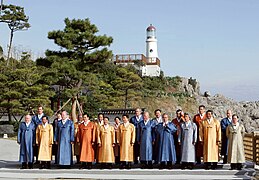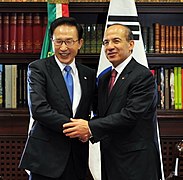
The nations Mexico and Russia initially established diplomatic relations in 1890. In 1924, Mexico recognized and established diplomatic relations with the Soviet Union. In 1930, Mexico broke diplomatic relations with the USSR and granted asylum to Leon Trotsky. In 1943, Mexico and the USSR re-established diplomatic relations. After the dissolution of the union, Mexico once again established diplomatic relations with the current Russian Federation in 1992.

The nations of Chile and Mexico established diplomatic relations in 1831, however, relations were severed in 1974 in the aftermath of the 1973 Chilean coup d'état. Diplomatic relations were re-established in 1990 and have continued unabated since.

The nations of Mexico and Turkey established diplomatic relations in 1928. Both nations are members of the G20, OECD and the United Nations.
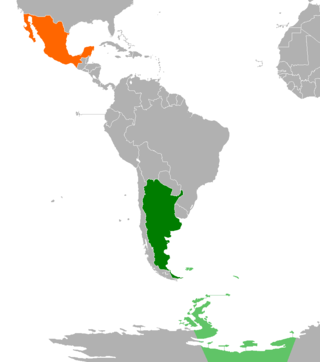
The nations of Argentina and Mexico established diplomatic relations in 1888. Both nations are members of the Community of Latin American and Caribbean States, G-20 major economies, Latin American Integration Association, Organization of American States, Organization of Ibero-American States and the United Nations.

The nations of Brazil and Mexico established diplomatic relations in 1825. Together, Brazil and Mexico account as the most populous nations in Latin America and both nations have the largest global emerging economies and are considered to be regional powers. Both countries are members of the Community of Latin American and Caribbean States, G-20 major economies, Latin American Integration Association, Organization of American States, Organization of Ibero-American States and the United Nations.

The nations of Colombia and Mexico established diplomatic relations in 1821 when Colombia became the first country in Latin-America to recognize Mexico's independence. Both nations are members of the Association of Caribbean States, Community of Latin American and Caribbean States, Latin American Integration Association, Organization of American States, Organization of Ibero-American States, Pacific Alliance and the United Nations.

Initial relations between Hungary and Mexico date back to the short reign of the Emperor Maximilian I of Mexico from 1864 to 1867. Diplomatic relations with the Austro-Hungarian Empire were established in 1901, and diplomatic relations continued between an independent Hungary and Mexico after the dissolution of the Austro-Hungarian Empire in 1918, however, diplomatic relations were once again suspended between 1941 and 1974. Diplomatic relations were re-established between both nations on 14 May 1974 and have continued unabated since.

The nations of Mexico and Uruguay established diplomatic relations in 1831. Both nations are members of the Community of Latin American and Caribbean States, Latin American Integration Association, Organization of American States, Organization of Ibero-American States and the United Nations.

Mexico–India relations, also called Mexican-Indian relations or Indo-Mexican relations, are the diplomatic relations between India and Mexico. Both nations are members of the G-20 major economies and the United Nations.

The nations of Iceland and Mexico established diplomatic relations in 1964. Both nations are mutual members of the Organisation for Economic Co-operation and Development, United Nations and the World Trade Organization.

China–Mexico relations are the diplomatic relations between the People's Republic of China and the United Mexican States. Diplomatic relations were established in 1972. and both nations are members of the Asia-Pacific Economic Cooperation, Forum of East Asia–Latin America Cooperation, G-20 major economies and the United Nations.
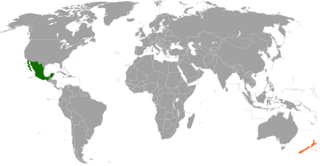
The nations of Mexico and New Zealand established diplomatic relations in 1973. Both nations are members of the Asia-Pacific Economic Cooperation, Comprehensive and Progressive Agreement for Trans-Pacific Partnership, Organisation for Economic Co-operation and Development, United Nations and the World Trade Organization.

Brazil–South Korea relations are the diplomatic relations between the Federative Republic of Brazil and the Republic of Korea. Both nations are members of the G20 and the United Nations.

The nations of Mexico and Portugal established diplomatic relations in 1864. Both nations are members of the Organization of Ibero-American States, Organisation for Economic Co-operation and Development and the United Nations.

The nations of Honduras and Mexico established diplomatic relations in 1879. Both nations are members of the Association of Caribbean States, Community of Latin American and Caribbean States, Organization of American States, Organization of Ibero-American States and the United Nations.

The nations of Mexico and Switzerland established diplomatic relations in 1945, however, both nations had established official contact in 1827. Both nations are members of the Organisation for Economic Co-operation and Development and the United Nations.

The nations of Mexico and Nicaragua established diplomatic relations in 1839, however, relations were briefly severed in May 1979 and restored a few months later in July 1979 with the ousting of Nicaraguan President Anastasio Somoza Debayle. Diplomatic relations between both nations have continued unabated since.
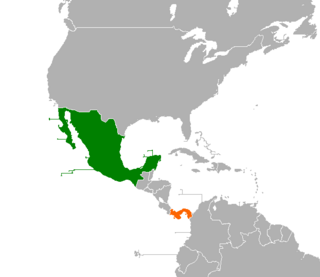
The nations of Mexico and Panama established diplomatic relations in 1904. Both nations are mutual members of the Association of Caribbean States, Community of Latin American and Caribbean States, Latin American Integration Association, Organization of Ibero-American States and the Organization of American States.

The nations of Mexico and the Democratic People's Republic of Korea established diplomatic relations in 1980. Both nations are members of the United Nations.

The nations of Mexico and Trinidad and Tobago established diplomatic relations in 1966. Both nations are members of the Association of Caribbean States, Community of Latin American and Caribbean States, Organization of American States and the United Nations.



